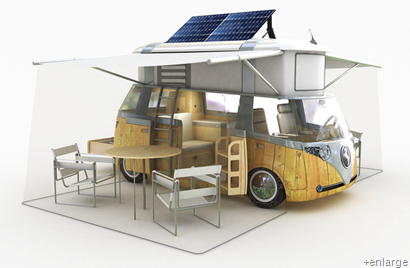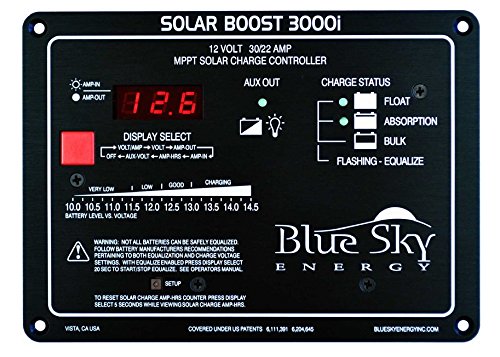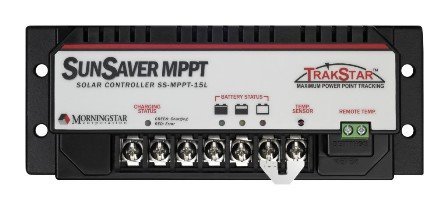Free and easy power from the sun! Solar power is gaining popularity as the price of panels comes slowly down, and the technology improves to the point where a good amount of electricity can be harvested from a relatively small space. I’ll cover solar as it pertains to camper vans here; for further information, check some of the recommended links at the bottom of the page.
For tips and information on mounting a solar panel to your van or vehicle, see Mounting a solar panel.
The basics / what you’ll need
For any solar system to work, you’ll need three major components:
- the solar panel or panels
- a solar controller
- storage battery or battery bank
Very briefly: your solar panel puts out a range of voltage, depending on the strength of the sun hitting the panel (dependent on angle, shading, etc). 12V solar panels actually put out about 17V at max, which would quickly cook your battery, so the power is run through a solar controller. The controller regulates the voltage down to a proper charging voltage, which depends on the state of charge of your battery. When the batteries are charged, for example, the controller will only allow about 13.4 volts to the battery – what’s known as a float charge.
Panels
 Panels obviously come in all shapes and sizes. Your panel or array (a setup of multiple panels) will depend on your energy needs. A good baseline is to plan for 1 watt of panel for every amp hour of battery capacity in your RV. So, if you’re carrying a 220Ah battery, you should consider about 200W of solar on top.
Panels obviously come in all shapes and sizes. Your panel or array (a setup of multiple panels) will depend on your energy needs. A good baseline is to plan for 1 watt of panel for every amp hour of battery capacity in your RV. So, if you’re carrying a 220Ah battery, you should consider about 200W of solar on top.
Panels up to about 130W are 12V panels; anything bigger is generally 24V. For all intents and purposes, this doesn’t mean much to you – just that you need to pick a controller that can handle the correct voltage. Higher voltage panels are advantageous in low-light situations, as they won’t drop below useful charging voltage (13.4 volts or so) as quickly as a 12 volt panel (which, remember, is really 17V). They’re also better with long runs of wire. But these differences in a small system aren’t really noticeable.
The most popular panels I’m seeing are the Renogy 100W panels – good price, manageable size, and a good reputation.
Controllers
Solar controllers are basically battery chargers. They accept the voltage coming from your panels, and convert it down to a useful charging voltage. There are two types of controllers: PWM, and MPPT. You want MPPT.
MPPT works like this: there are two important measures when charging a battery. Volts have to be at the correct level, in order to push the energy into the battery without overheating it. Amps are the ‘gas’ in the ‘gastank’ – your battery is charged when you’ve fed it enough amps to make up for the amps you’ve used. So, say your panel is putting out 7 amps at 17V. A regular controller will convert the 17V to a lower level, around 14V, to charge the battery. Nothing will happen to the 7 amps – they get fed into the battery.
An MPPT controller, among other things, converts the excess voltage (in our example, 17V – 14V = 3V) into amps, ‘boosting’ the amps that are being fed to the battery. In this manner, you might be able to push an additional 20% to 30% into the battery, speeding up the recharging time.
If your system is 24V or higher, you definitely want MPPT – using anything else is basically throwing away half of your amperage.
Recommended controllers are:
 |
Blue Sky Solar Boost 3000i (12V, 30A, 400W) |
 |
Morningstar SunSaver MPPT |
Batteries
I talk about batteries on the Batteries page – you can just consider solar as another energy source for a battery charger.
Wiring
Wire gauge
Most wire gauge charts figure a 5% drop over the specified distance – this is considered fine for electrical loads. However, with solar, where every amp matters, it’s recommended that no more than a 2-3% drop be introduced along the wire run. You can roughly halve the distance specified in typical wire gauge charts, or use the 3% setting on this solar wire gauge calculator.
Series vs. Parallel
If you’re connecting more than one panel together, you have two choices on how to wire them.
Series: connecting panels in series results in increased voltage – each panel’s voltage is added together. Series connections are positive to negative, and negative to positive.
Parallel: parallel connections increase the amperage, leaving the voltage unchanged. Parallel connections are achieved by connecting the positive terminals with the positive terminals, and the negative to the negative.
Connectors
New solar panels (as of late 2008) are coming out with MC4, aka SolarLine 2, connectors. These use a latching mechanism, and are required by code for residential/commercial applications. For a campervan, they’re not really useful (their usefulness lies in the ease of connecting large arrays) but you won’t want to cut them off and void your warranty. The solution is to buy an MC4 extension cable, cut it in half, and wire the cut ends into your system. The cheapest is a 3-foot length from Arizona Wind and Sun, though they only list down to 6 feet on their site. Give them a call to save a few bucks.
Recommended links
Arizona Wind and Sun: probably one of the most-frequently recommended sites for solar. They sell a good selection of quality solar gear, and also have great articles and a good forum with plenty of information about all aspects of solar. They’ll also respond quickly to email, if you have a specific question about their products.